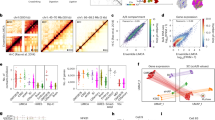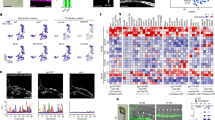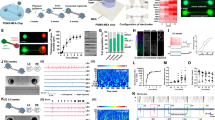Abstract
Neurons that produce gonadotropin-releasing hormone (GnRH), which control fertility, complete their nose-to-brain migration by birth. However, their function depends on integration within a complex neuroglial network during postnatal development. Here, we show that rodent GnRH neurons use a prostaglandin D2 receptor DP1 signaling mechanism during infancy to recruit newborn astrocytes that ‘escort’ them into adulthood, and that the impairment of postnatal hypothalamic gliogenesis markedly alters sexual maturation by preventing this recruitment, a process mimicked by the endocrine disruptor bisphenol A. Inhibition of DP1 signaling in the infantile preoptic region, where GnRH cell bodies reside, disrupts the correct wiring and firing of GnRH neurons, alters minipuberty or the first activation of the hypothalamic–pituitary–gonadal axis during infancy, and delays the timely acquisition of reproductive capacity. These findings uncover a previously unknown neuron-to-neural-progenitor communication pathway and demonstrate that postnatal astrogenesis is a basic component of a complex set of mechanisms used by the neuroendocrine brain to control sexual maturation.
This is a preview of subscription content, access via your institution
Access options
Access Nature and 54 other Nature Portfolio journals
Get Nature+, our best-value online-access subscription
$29.99 / 30 days
cancel any time
Subscribe to this journal
Receive 12 print issues and online access
$209.00 per year
only $17.42 per issue
Buy this article
- Purchase on Springer Link
- Instant access to full article PDF
Prices may be subject to local taxes which are calculated during checkout








Similar content being viewed by others
Data availability
Source data are provided with this paper, including uncropped western blots and transcriptomic data in GnV3 cells. Additional data that support the findings of this study are available from the corresponding authors upon request.
References
Moffitt, J. R. et al. Molecular, spatial, and functional single-cell profiling of the hypothalamic preoptic region. Science 362, eaau5324 (2018).
Casoni, F. et al. Development of the neurons controlling fertility in humans: new insights from 3D imaging and transparent fetal brains. Development 143, 3969–3981 (2016).
Chachlaki, K., Garthwaite, J. & Prevot, V. The gentle art of saying NO: how nitric oxide gets things done in the hypothalamus. Nat. Rev. Endocrinol. 13, 521–535 (2017).
Messina, A. et al. A microRNA switch regulates the rise in hypothalamic GnRH production before puberty. Nat. Neurosci. 19, 835–844 (2016).
Prevot, V. Puberty in mice and rats. in Knobil and Neill’s Physiology of Reproduction (eds. Plant, T. M. & Zeleznik, J.) 1395–1439 (Elsevier, New York, 2015).
Clasadonte, J. & Prevot, V. The special relationship: glia–neuron interactions in the neuroendocrine hypothalamus. Nat. Rev. Endocrinol. 14, 25–44 (2018).
Sloan, S. A. & Barres, B. A. Mechanisms of astrocyte development and their contributions to neurodevelopmental disorders. Curr. Opin. Neurobiol. 27, 75–81 (2014).
Verkhratsky, A. & Nedergaard, M. Physiology of astroglia. Physiol. Rev. 98, 239–389 (2018).
Barnabe-Heider, F. et al. Evidence that embryonic neurons regulate the onset of cortical gliogenesis via cardiotrophin-1. Neuron 48, 253–265 (2005).
Bandeira, F., Lent, R. & Herculano-Houzel, S. Changing numbers of neuronal and non-neuronal cells underlie postnatal brain growth in the rat. Proc. Natl Acad. Sci. USA 106, 14108–14113 (2009).
Elkharraz, K. et al. Paclitaxel-loaded microparticles and implants for the treatment of brain cancer: preparation and physicochemical characterization. Int. J. Pharm. 314, 127–136 (2006).
Wang, L. et al. Genetic dissection of the different roles of hypothalamic kisspeptin neurons in regulating female reproduction. Elife 8, e43999 (2019).
Mohr, M. A., DonCarlos, L. L. & Sisk, C. L. Inhibiting production of new brain cells during puberty or adulthood blunts the hormonally induced surge of luteinizing hormone in female rats. eNeuro 4, ENEURO.0133-17.2017 (2017).
Lopez-Rodriguez, D., Franssen, D., Bakker, J., Lomniczi, A. & Parent, A. S. Cellular and molecular features of EDC exposure: consequences for the GnRH network. Nat. Rev. Endocrinol. 17, 83–96 (2021).
Geens, T. et al. A review of dietary and non-dietary exposure to bisphenol A. Food Chem. Toxicol. 50, 3725–3740 (2012).
Franssen, D. et al. Delayed neuroendocrine sexual maturation in female rats after a very low dose of bisphenol A through altered GABAergic neurotransmission and opposing effects of a high dose. Endocrinology 157, 1740–1750 (2016).
Kuiri-Hanninen, T., Sankilampi, U. & Dunkel, L. Activation of the hypothalamic–pituitary–gonadal axis in infancy: minipuberty. Horm. Res. Paediatr. 82, 73–80 (2014).
Ciofi, P. Phenotypical segregation among female rat hypothalamic gonadotropin-releasing hormone neurons as revealed by the sexually dimorphic coexpression of cholecystokinin and neurotensin. Neuroscience 99, 133–147 (2000).
Chachlaki, K. et al. Phenotyping of nNOS neurons in the postnatal and adult female mouse hypothalamus. J. Comp. Neurol. 525, 3177–3189 (2017).
Mansuy, V. et al. Phenotypic and molecular characterization of proliferating and differentiated GnRH-expressing GnV-3 cells. Mol. Cell. Endocrinol. 332, 97–105 (2011).
Hirai, H. et al. Prostaglandin D2 selectively induces chemotaxis in T helper type 2 cells, eosinophils, and basophils via seven-transmembrane receptor CRTH2. J. Exp. Med. 193, 255–261 (2001).
Ohinata, K. et al. Central prostaglandin D2 stimulates food intake via the neuropeptide Y system in mice. FEBS Lett. 582, 679–684 (2008).
Tokudome, S. et al. Glucocorticoid protects rodent hearts from ischemia/reperfusion injury by activating lipocalin-type prostaglandin D synthase-derived PGD2 biosynthesis. J. Clin. Invest. 119, 1477–1488 (2009).
Kato, M., Ui-Tei, K., Watanabe, M. & Sakuma, Y. Characterization of voltage-gated calcium currents in gonadotropin-releasing hormone neurons tagged with green fluorescent protein in rats. Endocrinology 144, 5118–5125 (2003).
Ma, Y. J., Junier, M. P., Costa, M. E. & Ojeda, S. R. Transforming growth factor-alpha gene expression in the hypothalamus is developmentally regulated and linked to sexual maturation. Neuron 9, 657–670 (1992).
Rage, F., Lee, B. J., Ma, Y. J. & Ojeda, S. R. Estradiol enhances prostaglandin E2 receptor gene expression in luteinizing hormone-releasing hormone (LHRH) neurons and facilitates the LHRH response to PGE2 by activating a glia-to-neuron signaling pathway. J. Neurosci. 17, 9145–9156 (1997).
Lomniczi, A., Wright, H. & Ojeda, S. R. Epigenetic regulation of female puberty. Front. Neuroendocrinol. 36, 90–107 (2015).
Boehm, U., Zou, Z. & Buck, L. B. Feedback loops link odor and pheromone signaling with reproduction. Cell 123, 683–695 (2005).
Yoon, H., Enquist, L. W. & Dulac, C. Olfactory inputs to hypothalamic neurons controlling reproduction and fertility. Cell 123, 669–682 (2005).
Clasadonte, J., Scemes, E., Wang, Z., Boison, D. & Haydon, P. G. Connexin 43-mediated astroglial metabolic networks contribute to the regulation of the sleep–wake cycle. Neuron 95, 1365–1380 (2017).
Araque, A. et al. Gliotransmitters travel in time and space. Neuron 81, 728–739 (2014).
Clasadonte, J. et al. Prostaglandin E2 release from astrocytes triggers gonadotropin-releasing hormone (GnRH) neuron firing via EP2 receptor activation. Proc. Natl Acad. Sci. USA 108, 16104–16109 (2011).
Glanowska, K. M. & Moenter, S. M. Endocannabinoids and prostaglandins both contribute to GnRH neuron-GABAergic afferent local feedback circuits. J. Neurophysiol. 106, 3073–3081 (2011).
Bezzi, P. et al. Prostaglandins stimulate calcium-dependent glutamate release in astrocytes. Nature 391, 281–285 (1998).
Zonta, M. et al. Neuron-to-astrocyte signaling is central to the dynamic control of brain microcirculation. Nat. Neurosci. 6, 43–50 (2003).
Dziedzic, B. et al. Neuron-to-glia signaling mediated by excitatory amino acid receptors regulates ErbB receptor function in astroglial cells of the neuroendocrine brain. J. Neurosci. 23, 915–926 (2003).
Prevot, V. et al. Normal female sexual development requires neuregulin-ErbB receptor signaling in hypothalamic astrocytes. J. Neurosci. 23, 230–239 (2003).
Nagai, J. et al. Behaviorally consequential astrocytic regulation of neural circuits. Neuron 109, 576–596 (2021).
Bouret, S. G., Draper, S. J. & Simerly, R. B. Trophic action of leptin on hypothalamic neurons that regulate feeding. Science 304, 108–110 (2004).
Caron, E., Ciofi, P., Prevot, V. & Bouret, S. G. Alteration in neonatal nutrition causes perturbations in hypothalamic neural circuits controlling reproductive function. J. Neurosci. 32, 11486–11494 (2012).
Paul, A., Chaker, Z. & Doetsch, F. Hypothalamic regulation of regionally distinct adult neural stem cells and neurogenesis. Science 356, 1383–1386 (2017).
Sandau, U. S. et al. SynCAM1, a synaptic adhesion molecule, is expressed in astrocytes and contributes to ErbB4 receptor-mediated control of female sexual development. Endocrinology 152, 2364–2376 (2011).
Sandau, U. S. et al. The synaptic cell adhesion molecule, SynCAM1, mediates astrocyte-to-astrocyte and astrocyte-to-GnRH neuron adhesiveness in the mouse hypothalamus. Endocrinology 152, 2353–2363 (2011).
Allen, N. J. & Eroglu, C. Cell biology of astrocyte-synapse interactions. Neuron 96, 697–708 (2017).
Verkhratsky, A., Matteoli, M., Parpura, V., Mothet, J. P. & Zorec, R. Astrocytes as secretory cells of the central nervous system: idiosyncrasies of vesicular secretion. EMBO J. 35, 239–257 (2016).
Kofuji, P. & Araque, A. G-protein-coupled receptors in astrocyte–neuron communication. Neuroscience 456, 71–84 (2021).
Ullian, E. M., Sapperstein, S. K., Christopherson, K. S. & Barres, B. A. Control of synapse number by glia. Science 291, 657–661 (2001).
Pfrieger, F. W. & Barres, B. A. Synaptic efficacy enhanced by glial cells in vitro. Science 277, 1684–1687 (1997).
Papouin, T., Dunphy, J. M., Tolman, M., Dineley, K. T. & Haydon, P. G. Septal cholinergic neuromodulation tunes the astrocyte-dependent gating of hippocampal NMDA receptors to wakefulness. Neuron 94, 840–854 (2017).
Mu, Y. et al. Glia accumulate evidence that actions are futile and suppress unsuccessful behavior. Cell 178, 27–43 (2019).
Bourguignon, J. P., Gerard, A., Alvarex-Gonzalez, M. L., Fawe, L. & Franchimont, P. Gonadal-independent developmental changes in activation of N-methyl-d-aspartate receptors involved in gonadotropin-releasing hormone secretion. Neuroendocrinology 55, 634–641 (1992).
Carbone, S., Szwarcfarb, B., Otero Losada, M. E. & Moguilevsky, J. A. Effects of ovarian steroids on the gonadotropin response to N-methyl-d-aspartate and on hypothalamic excitatory amino acid levels during sexual maturation in female rats. Endocrinology 130, 1365–1370 (1992).
DeFazio, R. A., Heger, S., Ojeda, S. R. & Moenter, S. M. Activation of A-type gamma-aminobutyric acid receptors excites gonadotropin-releasing hormone neurons. Mol. Endocrinol. 16, 2872–2891 (2002).
Berg, T., Silveira, M. A. & Moenter, S. M. Prepubertal development of GABAergic transmission to gonadotropin-releasing hormone neurons and postsynaptic response are altered by prenatal androgenization. J. Neurosci. 38, 2283–2293 (2018).
Sardi, S. P., Murtie, J., Koirala, S., Patten, B. A. & Corfas, G. Presenilin-dependent ErbB4 nuclear signaling regulates the timing of astrogenesis in the developing brain. Cell 127, 185–197 (2006).
Veiga-Lopez, A., Beckett, E. M., Abi Salloum, B., Ye, W. & Padmanabhan, V. Developmental programming: prenatal BPA treatment disrupts timing of LH surge and ovarian follicular wave dynamics in adult sheep. Toxicol. Appl. Pharmacol. 279, 119–128 (2014).
Rasier, G. et al. Mechanisms of interaction of endocrine-disrupting chemicals with glutamate-evoked secretion of gonadotropin-releasing hormone. Toxicol. Sci. 102, 33–41 (2008).
Muncke, J. et al. Impacts of food contact chemicals on human health: a consensus statement. Environ. Health 19, 25 (2020).
O’Brien, E., Dolinoy, D. C. & Mancuso, P. Perinatal bisphenol A exposures increase production of pro-inflammatory mediators in bone marrow-derived mast cells of adult mice. J. Immunotoxicol. 11, 205–212 (2014).
Lamartiniere, C. A., Jenkins, S., Betancourt, A. M., Wang, J. & Russo, J. Exposure to the endocrine disruptor bisphenol A alters susceptibility for mammary cancer. Horm. Mol. Biol. Clin. Investig. 5, 45–52 (2011).
Burrows, R. C., Wancio, D., Levitt, P. & Lillien, L. Response diversity and the timing of progenitor cell maturation are regulated by developmental changes in EGFR expression in the cortex. Neuron 19, 251–267 (1997).
Gensburger, C., Labourdette, G. & Sensenbrenner, M. Brain basic fibroblast growth factor stimulates the proliferation of rat neuronal precursor cells in vitro. FEBS Lett. 217, 1–5 (1987).
Fujioka, H. et al. Generation of transgenic rats expressing enhanced green fluorescent protein in gonadotropin-releasing hormone neurons. J. Reprod. Dev. 49, 523–529 (2003).
Paxinos, G. & Watson, C. The Rat Brain in Stereotaxic Coordinates (Academic Press New York, 1982).
Ojeda, S. R. & Ramirez, V. D. Automatic control of LH and FSH secretion by short feedback circuits in immature rats. Endocrinology 84, 786–797 (1969).
Golde, W. T., Gollobin, P. & Rodriguez, L. L. A rapid, simple, and humane method for submandibular bleeding of mice using a lancet. Lab Anim. 34, 39–43 (2005).
Altwegg-Boussac, T., Chavez, M., Mahon, S. & Charpier, S. Excitability and responsiveness of rat barrel cortex neurons in the presence and absence of spontaneous synaptic activity in vivo. J. Physiol. 592, 3577–3595 (2014).
Salvi, R. et al. Gonadotropin-releasing hormone-expressing neurons immortalized conditionally are activated by insulin: implication of the mitogen-activated protein kinase pathway. Endocrinology 147, 816–826 (2006).
Swanson, L. W. Structure of the Rat Brain (Elsevier Science Publishers, Amsterdam, 2004).
Lee, W. S., Smith, M. S. & Hoffman, G. E. Luteinizing hormone-releasing hormone neurons express Fos protein during the proestrous surge of luteinizing hormone. Proc. Natl Acad. Sci. USA 87, 5163–5167 (1990).
Abercrombie, M. Estimation of nuclear population from microtome sections. Anat. Rec. 94, 239–247 (1946).
Tata, B. et al. Elevated prenatal anti-Mullerian hormone reprograms the fetus and induces polycystic ovary syndrome in adulthood. Nat. Med. 24, 834–846 (2018).
Schmittgen, T. D. & Livak, K. J. Analyzing real-time PCR data by the comparative CT method. Nat. Protoc. 3, 1101–1108 (2008).
Smyth, G. K. Limma: linear models for microarray data. in Bioinformatics and Computational Biology Solutions Using R and Bioconductor (eds. Gentleman, R. et al.) 397–420 (Springer, New York, 2005).
Storey, J. D. & Tibshirani, R. Statistical significance for genomewide studies. Proc. Natl Acad. Sci. USA 100, 9440–9445 (2003).
Vanacker, C. et al. Neuropilin-1 expression in GnRH neurons regulates prepubertal weight gain and sexual attraction. EMBO J. 39, e104633 (2020).
Acknowledgements
G.P. and M.M. were PhD students funded by the University of Lille and C.A. by the CHU Lille. We are most grateful to S. Charpier (Institut du Cerveau, UPMC-P6 UM 75, Paris, France) for precious insights in analyzing electrophysiological data and P. Giacobini (Inserm, Lille, France) for comments on the manuscript. We thank A. Dawid for data analysis (LiPhy, Grenoble), A. Caillet (U1172), N. Jouy (cytometry core facility, UMS2014-US41), M. Tardivel and A. Bongiovanni (microscopy core facility, UMS2014-US41), M. Fourdrinier (animal core facility, University of Lille) and A. Gérard (University of Liège) for expert technical assistance. We are indebted to G. Ternier for help in imaging analysis using IMARIS and to S. Nampoothiri for her work on the manuscript. This research was supported by the Fondation pour la Recherche Médicale (FRM, INE 2002), Agence Nationale de la Recherche (ANR, France) ANR-15-CE14–0025 (to V.P.), ANR-16-CE37-0006 (to V.P.), ANR-17-CE16-0015 (to V.P. and P.C.), the laboratory of excellence DISTALZ (ANR-11-LABX-0009 to V.P.) and I-SITE ULNE (ANR-16-IDEX-0004 ULNE to V.P.), the Association pour l’Etude des Anomalies Congénitales (AEAC; to A.S.) and the National Institutes of Health (1RO1 HD-084542 and 8P51OD011092 to S.R.O.).
Author information
Authors and Affiliations
Contributions
A.S., A.-S. P. and V.P. designed the experiments. G.P., M.M., C.A., T.L., S.G., D.F., V.M., M.M.-L., A C.-R., V.D., D.M., A.L., M.T.-S., P.C., A.S. and V.P. performed the experiments. A.S. and V.P. analyzed the data. J.S., G.C. and F.P. contributed material. All authors discussed the results and edited the manuscript. A.S., S.R., S.R.O. and V.P. wrote the manuscript.
Corresponding authors
Ethics declarations
Competing interests
The authors declare no competing interests.
Additional information
Peer review information Nature Neuroscience thanks Margaret McCarthy, Thomas Papouin and Ei Terasawa for their contribution to the peer review of this work.
Publisher’s note Springer Nature remains neutral with regard to jurisdictional claims in published maps and institutional affiliations.
Extended data
Extended Data Fig. 1 Association with astrocytes sculpts the GnRH neuron environment to regulate female sexual maturation.
At the beginning of the infantile period, astrocytes in the neighborhood of GnRH neurons release glial factors that stimulate the expression of the PGD2-synthesizing enzyme, PGDS, in GnRH neurons (1). The release of PGD2 by GnRH neurons (2) promotes the DP1-dependent attraction of neighboring glial progenitors to make close contact with the GnRH neurons (3). As more progenitors differentiate into astrocytes, they provide GnRH neurons with more astrocytic factors, thus amplifying the recruitment of even more progenitors (1, 2and 3). Increased astroglial coverage promotes the establishment of excitatory glutamatergic inputs to GnRH neurons (4) and provides GnRH neurons with higher levels of the gliotransmitter PGE2 (5), known to stimulate the electrical activity of GnRH neurons32 and to be necessary for proper sexual maturation5. Schematic created with Biorender.
Supplementary information
Supplementary Information
Supplementary Note, Supplementary Figs. 1–10 and Supplementary Tables 1–3
Supplementary Data 1
A list of genes upregulated and downregulated in GnV3 cells treated with hypothalamic ACM compared to unconditioned medium. Differential hybridized features were identified using Limma, a software package that implements linear models for microarray data (two sided). The Storey and Tibshirani method was used for multiple-comparisons adjustment (Methods).
Source data
Source Data Fig. 4
Unprocessed western blots.
Rights and permissions
About this article
Cite this article
Pellegrino, G., Martin, M., Allet, C. et al. GnRH neurons recruit astrocytes in infancy to facilitate network integration and sexual maturation. Nat Neurosci 24, 1660–1672 (2021). https://doi.org/10.1038/s41593-021-00960-z
Received:
Accepted:
Published:
Issue Date:
DOI: https://doi.org/10.1038/s41593-021-00960-z
This article is cited by
-
Metabolic control of puberty: 60 years in the footsteps of Kennedy and Mitra’s seminal work
Nature Reviews Endocrinology (2024)
-
Hypothalamic Kisspeptin Neurons: Integral Elements of the GnRH System
Reproductive Sciences (2023)
-
Glial cells as integrators of peripheral and central signals in the regulation of energy homeostasis
Nature Metabolism (2022)
-
Ontogenetic rules for the molecular diversification of hypothalamic neurons
Nature Reviews Neuroscience (2022)



